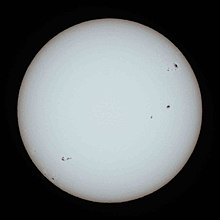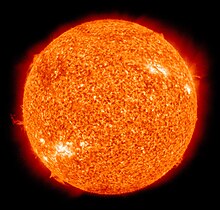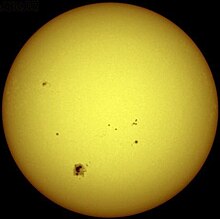الفرق بين النسختين بتاع: «شمس»
ص تزويد قوالب توماتيكى و/او تظبيط عن طريق اوب (12009) |
لا ملخص تعديل |
||
| سطر 1: | سطر 1: | ||
{{Infobox |
|||
| bodystyle = border-collapse:collapse |
|||
| title =الشمس Sun [[File:Sun symbol.svg|25px]] |
|||
| image = [[File:Sun white.jpg|frameless]] |
|||
| caption = Sun with [[sunspot]]s and [[limb darkening]] as seen in [[visible light]] with [[solar filter]]. |
|||
| image2 = [[File:The Sun by the Atmospheric Imaging Assembly of NASA's Solar Dynamics Observatory - 20100819.jpg|frameless]] |
|||
| caption2 = [[False color|False-color]] photo of the Sun as seen in [[ultraviolet light]] (wavelength of 30.4 nm) |
|||
| headerstyle = background:#FCC857 |
|||
| labelstyle = padding:2px |
|||
| datastyle = padding:2px |
|||
<!-- section break, rows 1-19--> |
|||
| header1 = Observation data |
|||
| label2 = Mean distance<br />from [[Earth]] |
|||
| data2 = 1 [[astronomical unit|au]] ≈ {{val|1.496|e=8|u=km}}<ref name="Pitjeva2009">{{Cite journal |last=Pitjeva |first=E. V. |last2=Standish |first2=E. M. |date=2009 |title=Proposals for the masses of the three largest asteroids, the Moon–Earth mass ratio and the Astronomical Unit |journal=[[Celestial Mechanics and Dynamical Astronomy]] |language=en |volume=103 |issue=4 |pages=365–372 |doi=10.1007/s10569-009-9203-8 |issn=1572-9478 |url=https://zenodo.org/record/1000691}}</ref><br />8 min 19 s at [[speed of light|light speed]] |
|||
| label3 = [[Apparent magnitude|Visual brightness]] (''V'') |
|||
| data3 = −26.74<ref name=nssdc>{{cite web |last=Williams |first=D.R. |date=1 July 2013 |title=Sun Fact Sheet |url=http://nssdc.gsfc.nasa.gov/planetary/factsheet/sunfact.html |publisher=[[NASA Goddard Space Flight Center]] |accessdate=12 August 2013 |archive-url=https://web.archive.org/web/20100715200549/http://nssdc.gsfc.nasa.gov/planetary/factsheet/sunfact.html |archive-date=15 July 2010 |url-status=dead}}</ref> |
|||
| label4 = [[Absolute magnitude]] |
|||
| data4 = 4.83<ref name=nssdc /> |
|||
| label5 = [[Stellar classification|Spectral classification]] |
|||
| data5 = G2V<ref>{{cite book |last=Zombeck |first=Martin V. |date=1990 |title=Handbook of Space Astronomy and Astrophysics 2nd edition |publisher=[[Cambridge University Press]] |url=http://ads.harvard.edu/books/hsaa/}}</ref> |
|||
| label6 = [[Metallicity]] |
|||
| data6 = ''Z'' = 0.0122<ref>{{cite journal |last1=Asplund |first1=M. |last2=Grevesse |first2=N. |last3=Sauval |first3=A.J. |date=2006 |title=The new solar abundances – Part I: the observations |journal=Communications in Asteroseismology |volume=147 |pages=76–79 |bibcode=2006CoAst.147...76A |doi=10.1553/cia147s76}}</ref> |
|||
| label7 = [[Angular size]] |
|||
| data7 = 31.6–32.7 [[minutes of arc]]<ref>{{cite web |title=Eclipse 99: Frequently Asked Questions |url=http://education.gsfc.nasa.gov/eclipse/pages/faq.html |publisher=NASA |accessdate=24 October 2010 |url-status=dead |archiveurl=https://web.archive.org/web/20100527142627/http://education.gsfc.nasa.gov/eclipse/pages/faq.html |archivedate=27 May 2010 |df=}}</ref> |
|||
| label8 = Adjectives |
|||
| data8 = Solar |
|||
| header10 = [[Orbit]]al characteristics |
|||
| label11 = Mean distance<br />from [[Milky Way]] core |
|||
| data11 = ≈ {{val|2.7|e=17|u=km}}<br />{{nowrap|{{val|fmt=commas|27200|ul=light-years}}}} |
|||
| label12 = [[Galactic year|Galactic period]] |
|||
| data12 = (2.25–2.50){{e|8}} [[julian year (astronomy)|yr]] |
|||
| label13 = [[Velocity]] |
|||
| data13 = ≈ {{val|220|u=km/s}} (orbit around the center of the Milky Way) <br />≈ {{val|20|u=km/s}} (relative to average velocity of other stars in stellar neighborhood) <br />≈ {{val|370|u=km/s}}<ref>{{cite journal |last=Hinshaw |first=G. |display-authors=etal |year=2009 |title=Five-year Wilkinson Microwave Anisotropy Probe observations: data processing, sky maps, and basic results |journal=[[The Astrophysical Journal Supplement Series]] |volume=180 |issue=2 |pages=225–245 |arxiv=0803.0732 |bibcode=2009ApJS..180..225H |doi=10.1088/0067-0049/180/2/225}}</ref> (relative to the [[Cosmic microwave background radiation#CMBR dipole anisotropy|cosmic microwave background]]) |
|||
<!-- section break, rows 20–39 --> |
|||
| header20 = Physical characteristics |
|||
| label21 = Equatorial [[radius]] |
|||
| data21 = [[Solar radius|695,700]] km,<ref name=IAU2015resB3>{{cite arxiv |first1=E.E. |last1=Mamajek |first2=A. |last2=Prsa |first3=G. |last3=Torres |first4=al. |last4=et |title=IAU 2015 Resolution B3 on Recommended Nominal Conversion Constants for Selected Solar and Planetary Properties |eprint=1510.07674 |mode=cs2 |class=astro-ph.SR |year=2015}}</ref><br /> 696,342 km<ref name=arxiv1203_4898>{{citation |first1=Marcelo |last1=Emilio |first2=Jeff R. |last2=Kuhn |first3=Rock I. |last3=Bush |first4=Isabelle F. |last4=Scholl |title=Measuring the Solar Radius from Space during the 2003 and 2006 Mercury Transits |arxiv=1203.4898 |bibcode=2012ApJ...750..135E |doi=10.1088/0004-637X/750/2/135 |volume=750 |issue=2 |journal=The Astrophysical Journal |page=135 |year=2012}}</ref><br />{{val|109|u=[[Earth radius|× Earth]]}}<ref name=sse/> |
|||
| label22 = Equatorial [[circumference]] |
|||
| data22 = {{val|4.379|e=6|u=km}}<ref name=sse/><br />109 × Earth<ref name=sse>{{cite web |title=Solar System Exploration: Planets: Sun: Facts & Figures |url=http://solarsystem.nasa.gov/planets/profile.cfm?Object=Sun&Display=Facts&System=Metric |archiveurl=https://web.archive.org/web/20080102034758/http://solarsystem.nasa.gov/planets/profile.cfm?Object=Sun&Display=Facts&System=Metric |archivedate=2 January 2008 |publisher=NASA}}</ref> |
|||
| label23 = [[Flattening]] |
|||
| data23 = {{val|9|e=-6}} |
|||
| label24 = [[Surface area]] |
|||
| data24 = {{val|6.09|e=12|u=km2}}<ref name=sse/><br />{{nowrap|{{val|fmt=commas|12000}}}} × Earth<ref name=sse/> |
|||
| label25 = [[Volume]] |
|||
| data25 = {{val|1.41|e=18|u=km3}}<ref name=sse/><!-- NASA source has "1.412 x 10^18 km^3", which is 1.412 × 10^27 m^3 (basic arithmetic, also verified using the formula for volume of a sphere), but the Sun is not a sphere, and their radius is off a bit from what we have above, so we need to at least round a bit--><br />{{nowrap|{{val|fmt=commas|1300000}}}} × Earth |
|||
| label26 = [[Mass]] |
|||
| data26 = {{val|1.9885||e=30|u=kg}}<ref name=nssdc/><br />{{nowrap|{{val|fmt=commas|333000|u=[[Mass of Earth|× Earth]]}}}}<ref name=nssdc/><!-- NASA Sun Fact Sheet states 333,000, a figure coherent with data already present in en.wiki --> |
|||
| label27 = Average [[density]] |
|||
| data27 = {{val|1.408|u=g/cm3}}<ref name=nssdc/><ref name=sse/><ref>{{cite web |last=Ko |first=M. |date=1999 |title=Density of the Sun |url=http://hypertextbook.com/facts/1999/MayKo.shtml |editor=Elert, G. |website=The Physics Factbook}}</ref><br />{{val|0.255}} × Earth<ref name=nssdc/><ref name=sse/> |
|||
| label28 = Center [[density]] (modeled) |
|||
| data28 = {{val|162.2|u=g/cm3}}<ref name=nssdc/><br />{{val|12.4}} × Earth |
|||
| label29 = Equatorial [[surface gravity]] |
|||
| data29 = {{val|274|u=m/s2}}<ref name=nssdc/><br />28 × Earth<ref name=sse/> |
|||
| label30 = [[Moment of inertia factor]] |
|||
| data30 = {{val|0.070}}<ref name=nssdc /> (estimate) |
|||
| label31 = [[Escape velocity]]<br />(from the surface) |
|||
| data31 = {{val|617.7|u=km/s}}<ref name=sse/><br />55 × Earth<ref name=sse/> |
|||
| label32 = Temperature |
|||
| data32 = Center (modeled): {{val|1.57|e=7|u=K}}<ref name=nssdc/><br />[[Photosphere]] (effective): {{nowrap|{{val|fmt=commas|5772|ul=K}}}}<ref name=nssdc/><br /> [[Corona]]: ≈ {{val|5|e=6|u=K}} |
|||
| label33 = [[Luminosity]] (L<sub>sol</sub>) |
|||
| data33 = {{val|3.828|e=26|ul=W}}<ref name=nssdc/><br />≈ {{val|3.75|e=28|u=[[lumen (unit)|lm]]}}<br />≈ {{val|98|u=lm/W}} [[Luminous efficacy|efficacy]] |
|||
| label34 = [[Color index|Color]] (B-V) |
|||
| data34 = 0.63 |
|||
| label35 = Mean [[radiance]] (I<sub>sol</sub>) |
|||
| data35 = {{val|2.009|e=7|u=W·m<sup>−2</sup>·sr<sup>−1</sup>}} |
|||
| label36 = Age |
|||
| data36 = ≈ 4.6 billion years<ref name="Bonanno">{{Cite journal |last=Bonanno |first=A. |last2=Schlattl |first2=H. |last3=Paternò |first3=L. |year=2002 |title=The age of the Sun and the relativistic corrections in the EOS |journal=[[Astronomy and Astrophysics]] |volume=390 |issue=3 |pages=1115–1118 |arxiv=astro-ph/0204331 |bibcode=2002A&A...390.1115B |doi=10.1051/0004-6361:20020749 |ref=harv}}</ref><ref>{{Cite journal |title=The Absolute Chronology and Thermal Processing of Solids in the Solar Protoplanetary Disk |date=2 November 2012 |doi=10.1126/science.1226919 |journal=Science |volume=338 |issue=6107 |pages=651–655 |bibcode=2012Sci...338..651C |pmid=23118187 |last1=Connelly |first1=JN |last2=Bizzarro |first2=M |last3=Krot |first3=AN |last4=Nordlund |first4=Å |last5=Wielandt |first5=D |last6=Ivanova |first6=MA}}{{Registration required}}</ref> |
|||
<!-- section break, rows 40–49 --> |
|||
| header40 = [[Rotation]] characteristics |
|||
| label41 = [[Axial tilt|Obliquity]] |
|||
| data41 = 7.25°<ref name=nssdc/><br />(to the [[ecliptic]])<br />67.23°<br />(to the [[galactic plane]]) |
|||
| label42 = [[Right ascension]]<br />of North pole<ref name="iau-iag">{{cite web |last1=Seidelmann |first1=P.K. |display-authors=etal |title=Report Of The IAU/IAG Working Group On Cartographic Coordinates And Rotational Elements Of The Planets And Satellites: 2000 |url=http://www.hnsky.org/iau-iag.htm |date=2000 |accessdate=22 March 2006}}</ref> |
|||
| data42 = 286.13°<br />{{nowrap|19 h 4 min 30 s}} |
|||
| label43 = [[Declination]]<br />of North pole |
|||
| data43 = +63.87°<br />63° 52' North |
|||
| label44 = Sidereal [[Solar rotation|rotation period]] <br />(at equator) |
|||
| data44 = 25.05 d<ref name=nssdc/> |
|||
| label45 = (at 16° latitude) |
|||
| data45 = 25.38 d<ref name=nssdc/><br />{{nowrap|25 d 9 h 7 min 12 s}}<ref name="iau-iag"/> |
|||
| label46 = (at poles) |
|||
| data46 = 34.4 d<ref name=nssdc/><!-- derived from T = ( 14.37 − 2.33 sin^2 L − 1.56 sin^4 L ) °/day, L = 90° --> |
|||
| label47 = Rotation velocity<br />(at equator) |
|||
| data47 = {{val|7.189|e=3|u=km/h}}<ref name="sse"/><!-- Derived from NASA source: equatorial circumference of 4,379,000 kilometers divided by sidereal rotation period of 609.12 hours; maybe this kind of basic calculation could be done in some generic template code? --> |
|||
<!-- section break, rows 50–69 --> |
|||
| header50 = [[photosphere|Photospheric]] composition (by mass) |
|||
| label51 = [[Hydrogen]] |
|||
| data51 = 73.46%<ref>{{cite web |title=The Sun's Vital Statistics |url=http://solar-center.stanford.edu/vitalstats.html |publisher=Stanford Solar Center |accessdate=29 July 2008}} Citing {{cite book |last=Eddy |first=J. |date=1979 |title=A New Sun: The Solar Results From Skylab |url=https://history.nasa.gov/SP-402/contents.htm |page=37 |publisher=NASA |id=NASA SP-402}}</ref> |
|||
| label52 = [[Helium]] |
|||
| data52 = 24.85% |
|||
| label53 = [[Oxygen]] |
|||
| data53 = 0.77% |
|||
| label54 = [[Carbon]] |
|||
| data54 = 0.29% |
|||
| label55 = [[Iron]] |
|||
| data55 = 0.16% |
|||
| label56 = [[Neon]] |
|||
| data56 = 0.12% |
|||
| label57 = [[Nitrogen]] |
|||
| data57 = 0.09% |
|||
| label58 = [[Silicon]] |
|||
| data58 = 0.07% |
|||
| label59 = [[Magnesium]] |
|||
| data59 = 0.05% |
|||
| label60 = [[Sulphur]] |
|||
| data60 = 0.04% |
|||
}} |
|||
[[ملف:Sun920607.jpg|220PX|thumb|left|الشمس]] |
[[ملف:Sun920607.jpg|220PX|thumb|left|الشمس]] |
||
'''الشمس''' هى كوره ضخمه متوهجه موجوده فى نص [[نظام شمسى|النظام الشمسى]] و بتمد ال[[الارض|ارض]] بال[[طاقه]] بصورها المختلفه زى ال[[نور]] و ال[[حراره]].الشمس بتعتبر [[نجمه]] من ضمن 100 مليون نجمه موجوده فى [[مجرة]] [[درب التبانه]]. |
'''الشمس''' هى كوره ضخمه متوهجه موجوده فى نص [[نظام شمسى|النظام الشمسى]] و بتمد ال[[الارض|ارض]] بال[[طاقه]] بصورها المختلفه زى ال[[نور]] و ال[[حراره]].الشمس بتعتبر [[نجمه]] من ضمن 100 مليون نجمه موجوده فى [[مجرة]] [[درب التبانه]]. |
||
تعديلات من 13:19، 24 ديسمبر 2019
 | |
 False-color photo of the Sun as seen in ultraviolet light (wavelength of 30.4 nm) | |
| Observation data | |
|---|---|
| Mean distance from Earth | 1 au ≈ 1.496×108 km[1] 8 min 19 s at light speed |
| Visual brightness (V) | −26.74[2] |
| Absolute magnitude | 4.83[2] |
| Spectral classification | G2V[3] |
| Metallicity | Z = 0.0122[4] |
| Angular size | 31.6–32.7 minutes of arc[5] |
| Adjectives | Solar |
| Orbital characteristics | |
| Mean distance from Milky Way core | ≈ 2.7×1017 km 27,200 light-years |
| Galactic period | (2.25–2.50)قالب:E yr |
| Velocity | ≈ 220 km/s (orbit around the center of the Milky Way) ≈ 20 km/s (relative to average velocity of other stars in stellar neighborhood) ≈ 370 km/s[6] (relative to the cosmic microwave background) |
| Physical characteristics | |
| Equatorial radius | 695,700 km,[7] 696,342 km[8] 109 × Earth[9] |
| Equatorial circumference | 4.379×106 km[9] 109 × Earth[9] |
| Flattening | 9×10−6 |
| Surface area | 6.09×1012 km2[9] 12,000 × Earth[9] |
| Volume | 1.41×1018 km3[9] 1,300,000 × Earth |
| Mass | 1.9885×1030 kg[2] 333,000 × Earth[2] |
| Average density | 1.408 g/cm3[2][9][10] 0.255 × Earth[2][9] |
| Center density (modeled) | 162.2 g/cm3[2] 12.4 × Earth |
| Equatorial surface gravity | 274 m/s2[2] 28 × Earth[9] |
| Moment of inertia factor | 0.070[2] (estimate) |
| Escape velocity (from the surface) | 617.7 km/s[9] 55 × Earth[9] |
| Temperature | Center (modeled): 1.57×107 K[2] Photosphere (effective): 5,772 K[2] Corona: ≈ 5×106 K |
| Luminosity (Lsol) | 3.828×1026 W[2] ≈ 3.75×1028 lm ≈ 98 lm/W efficacy |
| Color (B-V) | 0.63 |
| Mean radiance (Isol) | 2.009×107 W·m−2·sr−1 |
| Age | ≈ 4.6 billion years[11][12] |
| Rotation characteristics | |
| Obliquity | 7.25°[2] (to the ecliptic) 67.23° (to the galactic plane) |
| Right ascension of North pole[13] | 286.13° 19 h 4 min 30 s |
| Declination of North pole | +63.87° 63° 52' North |
| Sidereal rotation period (at equator) | 25.05 d[2] |
| (at 16° latitude) | 25.38 d[2] 25 d 9 h 7 min 12 s[13] |
| (at poles) | 34.4 d[2] |
| Rotation velocity (at equator) | 7.189×103 km/h[9] |
| Photospheric composition (by mass) | |
| Hydrogen | 73.46%[14] |
| Helium | 24.85% |
| Oxygen | 0.77% |
| Carbon | 0.29% |
| Iron | 0.16% |
| Neon | 0.12% |
| Nitrogen | 0.09% |
| Silicon | 0.07% |
| Magnesium | 0.05% |
| Sulphur | 0.04% |

الشمس هى كوره ضخمه متوهجه موجوده فى نص النظام الشمسى و بتمد الارض بالطاقه بصورها المختلفه زى النور و الحراره.الشمس بتعتبر نجمه من ضمن 100 مليون نجمه موجوده فى مجرة درب التبانه.
الشمس بتتكون من غازات ليها صفات مخصوصه جدا و عشان كدا بيسميها العلما بتوع الفيزيا البلازما.بيلف حوالين الشمس 9 كواكب مع الاقمار بتاعتهم (من ضمنهم الارض و القمر بتاعها) و كمان بيلف حواليها عشرات الالاف من الكويكبات و تريليونات المذنبات.الشمس و كل الاجسام اللى بتلف حواليها دى بتقال عليهم النظام الشمسى.الارض بينها و بين الشمس 149,600,000 كيلو متر.
نص قطر الشمس (المسافه من مركزالشمس لحد سطحها) بيساوى 695,500 كم تقريبا قد نص قطر الارض ب 109 مره.الشمس درجة حرارتها عاليه جدا ، سطح الشمس حرارته بتوصل لـ 5500 سيلزيوس او 5800 كيلفين و درجة حرارة مركزها بتوصل لـ 15 مليون كيلفين.
الطاقه بتاعة الشمس دى جايه من التفاعلات النوويه اللى بتحصل فى قلبها، كل نواتين بتوع ذرتين هايدروجين بيتحدو مع بعض فى تفاعل نووى اندماجى و بيطلعو ذرة هيليوم واحده.كتلة ذرة الهيليوم دى اقل بشويه من مجموع الكتلتين بتوع ذرتين الهايدروجين اللى دخلو فى التفاعل.الفرق فى الكتله بين ذرتين الهايدروجين و ذرة الهيليوم بيتحول لطاقه اللى بتشع الحراره و النور و بتحفذ الذرات التانيه انها تندمج مع بعض بنفس الطريقه. على مدى بلايين السنين كتلة الشمس عماله تقل و حجمها عمال يصغر لانها بتستهلك نفسها بنفسها.
لينكات
- ↑ Pitjeva, E. V.; Standish, E. M. (2009). "Proposals for the masses of the three largest asteroids, the Moon–Earth mass ratio and the Astronomical Unit". Celestial Mechanics and Dynamical Astronomy (in الإنجليزية). 103 (4): 365–372. doi:10.1007/s10569-009-9203-8. ISSN 1572-9478.
- ↑ أ ب ت ث ج ح خ د ذ ر ز س ش ص ض ط Williams, D.R. (1 July 2013). "Sun Fact Sheet". NASA Goddard Space Flight Center. Archived from the original on 15 July 2010. Retrieved 12 August 2013.
- ↑ Zombeck, Martin V. (1990). Handbook of Space Astronomy and Astrophysics 2nd edition. Cambridge University Press.
- ↑ Asplund, M.; Grevesse, N.; Sauval, A.J. (2006). "The new solar abundances – Part I: the observations". Communications in Asteroseismology. 147: 76–79. Bibcode:2006CoAst.147...76A. doi:10.1553/cia147s76.
- ↑ "Eclipse 99: Frequently Asked Questions". NASA. Archived from the original on 27 May 2010. Retrieved 24 October 2010.
- ↑ Hinshaw, G.; et al. (2009). "Five-year Wilkinson Microwave Anisotropy Probe observations: data processing, sky maps, and basic results". The Astrophysical Journal Supplement Series. 180 (2): 225–245. arXiv:0803.0732. Bibcode:2009ApJS..180..225H. doi:10.1088/0067-0049/180/2/225.
- ↑ Mamajek, E.E.; Prsa, A.; Torres, G.; et, al. (2015), "IAU 2015 Resolution B3 on Recommended Nominal Conversion Constants for Selected Solar and Planetary Properties", arXiv:1510.07674 [astro-ph.SR]
- ↑ Emilio, Marcelo; Kuhn, Jeff R.; Bush, Rock I.; Scholl, Isabelle F. (2012), "Measuring the Solar Radius from Space during the 2003 and 2006 Mercury Transits", The Astrophysical Journal, 750 (2): 135, arXiv:1203.4898, Bibcode:2012ApJ...750..135E, doi:10.1088/0004-637X/750/2/135
- ↑ أ ب ت ث ج ح خ د ذ ر ز س "Solar System Exploration: Planets: Sun: Facts & Figures". NASA. Archived from the original on 2 January 2008.
- ↑ Ko, M. (1999). Elert, G. (ed.). "Density of the Sun". The Physics Factbook.
- ↑ Bonanno, A.; Schlattl, H.; Paternò, L. (2002). "The age of the Sun and the relativistic corrections in the EOS". Astronomy and Astrophysics. 390 (3): 1115–1118. arXiv:astro-ph/0204331. Bibcode:2002A&A...390.1115B. doi:10.1051/0004-6361:20020749.
{{cite journal}}: Invalid|ref=harv(help) - ↑ Connelly, JN; Bizzarro, M; Krot, AN; Nordlund, Å; Wielandt, D; Ivanova, MA (2 November 2012). "The Absolute Chronology and Thermal Processing of Solids in the Solar Protoplanetary Disk". Science. 338 (6107): 651–655. Bibcode:2012Sci...338..651C. doi:10.1126/science.1226919. PMID 23118187.(registration required)
- ↑ أ ب Seidelmann, P.K.; et al. (2000). "Report Of The IAU/IAG Working Group On Cartographic Coordinates And Rotational Elements Of The Planets And Satellites: 2000". Retrieved 22 March 2006.
- ↑ "The Sun's Vital Statistics". Stanford Solar Center. Retrieved 29 July 2008. Citing Eddy, J. (1979). A New Sun: The Solar Results From Skylab. NASA. p. 37. NASA SP-402.

